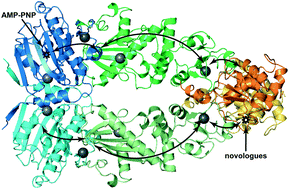Molecular insights into the interaction of Hsp90 with allosteric inhibitors targeting the C-terminal domain†
Abstract
Unique to targeting the C-terminal domain of Hsp90 (C-Hsp90) is the ability to uncouple the cytotoxic and cytoprotective outcomes of Hsp90 modulation. After the identification of novobiocin as a C-Hsp90 interacting ligand a diverse gamut of novologues emerged, from which KU-32 and KU-596 exhibited strong neuroprotective activity. However, further development of these ligands is hampered by the difficulty to obtain structural information on their complexes with Hsp90. Using saturation transfer difference (STD) NMR spectroscopy, we found that the primary binding epitopes of KU-32 and KU596 map at the ring systems of the ligands and specifically the coumarin and biphenyl structures, respectively. Based on both relative and absolute STD effects, we identified KU-596 sites that can be explored to design novel third-generation novologues. In addition, chemical shift perturbations obtained by methyl-TROSY reveal that novologues bind at the cryptic, C-Hsp90 ATP-binding pocket and produce global, long-range structural rearrangements to dimeric Hsp90.



 Please wait while we load your content...
Please wait while we load your content...